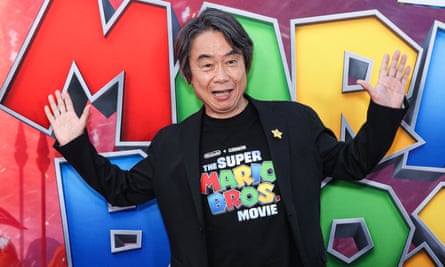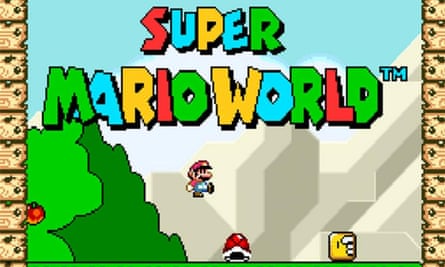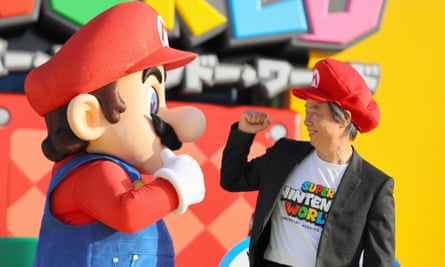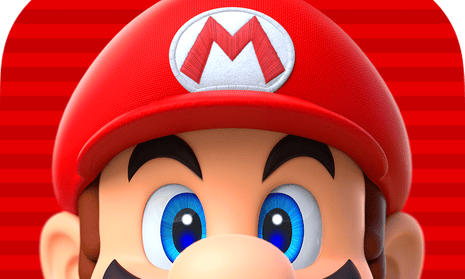It’s official: the new Super Mario Bros film has broken a long-established trend of lacklustre video game tie-in movies by becoming a vast success. Zooming past the $500m mark in nine days, it has smashed box office records for animated films and it’s also the highest grossing film of 2023 so far.
But if you don’t play games, you might be wondering what on earth is going on. How did a portly man in dungarees become a global superstar? Here is a quick recap …
A brief history
Mario made his first appearance in the classic 1981 arcade game Donkey Kong, created for Nintendo by fledgling designer Shigeru Miyamoto. Originally known as Jumpman, the character’s appearance was not an aesthetic choice, but the result of graphical limitations: because the character was constructed on a tiny 16x16 pixel grid, the moustache and dungarees were necessary to make his face and arms discernible.

Donkey Kong laid down the foundations of the platforming game genre – ladders, platforms and jumping – and in 1983, Miyamoto began working on a follow-up. He changed the name of the lead character to Mario – inspired by Nintendo of America’s New York landlord, Mario Segale. Originally released as an arcade game, Mario Bros, saw the eponymous character and his near-identical sibling Luigi clearing the Manhattan sewer system of invading turtles. Although the action was basic, it was popular enough to inspire a wealth of home computer versions – and so Mario arrived on the ZX Spectrum, Commodore 64, Atari 2600 and, of course, the Nintendo Entertainment System. The accidental Italian plumber was suddenly a very big deal.
From 1985 to the early 1990s, he starred in the Super Mario Bros series, which took him out of the sewers and into his own colourful fantasy world: the Mushroom Kingdom. While Mario Bros featured a series of single-screen levels, Super Mario Bros featured scrolling stages that changed as he ran from left to right, and a supporting cast of characters including Princess Peach, the mushroom-like Goomba enemies, the reptilian Koopa Troopers and Mario’s arch-nemesis Bowser (originally known as King Koopa).
Released on the venerable Nintendo Entertainment System, the Super Mario Bros games are among the most famous and successful video games of all time. The first games sold almost 60m copies, making Mario more recognisable to American children than Mickey Mouse in the 90s. With the arrival of the Super Nintendo Entertainment System (SNES) console in 1990 came the more ambitious and advanced Super Mario World titles, with beautiful pixel art and a navigable map allowing different routes through the story. The SNES also saw two of the greatest Mario spin-offs: Super Mario Kart and Super Mario RPG: Legend of the Seven Stars.

In 1996, Nintendo released Super Mario 64 for the Nintendo 64. It was the first Mario game with real-time rendered 3D graphics, freeing the character from his 2D side-scrolling and letting him run (and jump) free. Using the console’s analogue stick controller, Miyamoto developed an innovative and accessible way to control the character in three dimensions, inspiring a new era of platforming adventures such as Crash Bandicoot, Spyro the Dragon and Jak & Daxter. From this point on, every new Nintendo console and handheld device had its own Super Mario series. On the Game Boy it was Super Mario Land, on the GameCube it was Super Mario Sunshine, on the Wii, Super Mario Galaxy; each brought new ideas and innovations, but all held true to the spirit of the series – a lovable set of characters, running, jumping and exploring through colourfully mysterious, secret-filled landscapes.
What’s the best Mario game to get started with?
The easiest way to discover Mario is to buy a Nintendo Switch console and a copy of the latest and one of the best Mario titles, Super Mario Odyssey (if you buy the current Nintendo Switch Super Mario Movie bundle for £260, you get Odyssey free). It’s a beautiful, clever and entertaining game and it explains everything you need to know about the series and its conventions.
On Switch, you can also play Super Mario 3D World + Bowser’s Fury, and New Super Mario Bros U Deluxe, multiplayer Mario games that you can play with friends and family. If you played Mario in two dimensions in the 80s or 90s, you might also enjoy Super Mario Maker 2, which lets you create your own 2D Super Mario games. Furthermore, if you subscribe to Nintendo’s online service you get access to a collection of retro Mario games from the NES, SNES and N64 eras. We would recommend Super Mario Bros 3, Super Mario World and Super Mario Bros: The Lost Levels.

Alternatively, if you just want a handy retro Mario experience, the lovely Super Mario Game + Watch handheld is available for £35 and lets you play Super Mario Bros and Super Mario Bros: The Lost Levels on a teeny screen. You could also pick up a secondhand DS or 3DS and play a wealth of portable Mario games. Mario & Luigi: Partners in Time, New Super Mario Bros, Super Mario 3D Land and Mario & Luigi: Bowser’s Inside Story are all excellent.
after newsletter promotion
If you have a smartphone, you can play Super Mario Run, an “endless runner” game in which you time your taps on the screen to avoid obstacles. It’s a fun variation on the classic games, well designed for playing on the move.
And, of course, if racing sounds more appealing than running and jumping, there’s always Mario Kart, by far the most successful and most fun Mario spin-off.

Do I have to be good at games to appreciate Super Mario?
No. Miyamoto is often referred to as the Steven Spielberg of games and not just because his games have been monumentally successful. Like Spielberg’s movies, the Super Mario games are highly accessible and intuitive, while still offering considerable depth. They are carefully structured to ensure even complete beginners are able to understand what is going on and become proficient. All the necessary skills are taught as you go along, sometimes without you even being consciously aware of it. By the time you finish a few levels, you will find that you have mastered the controls – which is exactly when you will encounter a major boss character or challenging platforming section to test your newfound skills.
The Super Mario games are effectively interactive fairy tales; they have that same sort of universal appeal. Even if you occasionally have to hand over control to a more experienced player, you can appreciate the beauty of the worlds, characters and stories.
Further reading
Super Mario Bros: 25 Mario facts for the 25th anniversary.

Comments (…)
Sign in or create your Guardian account to join the discussion